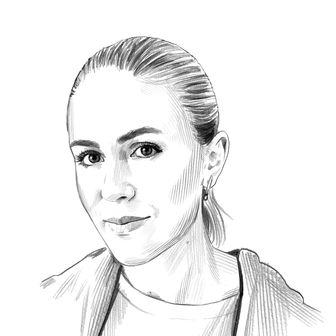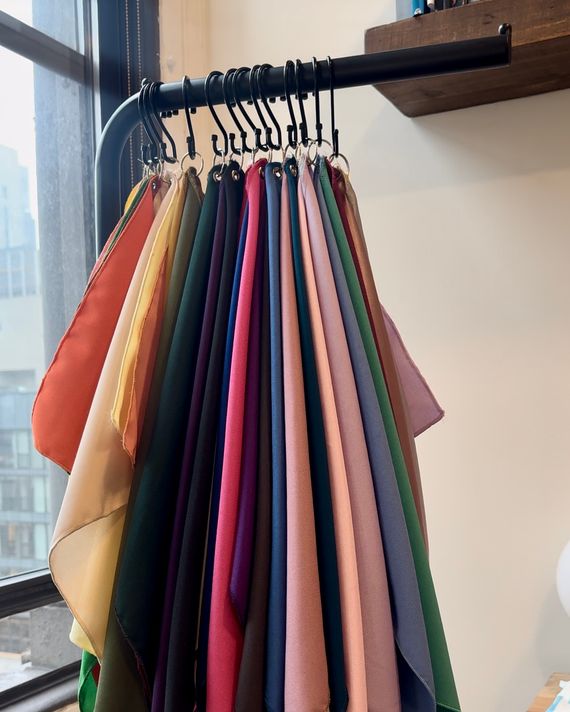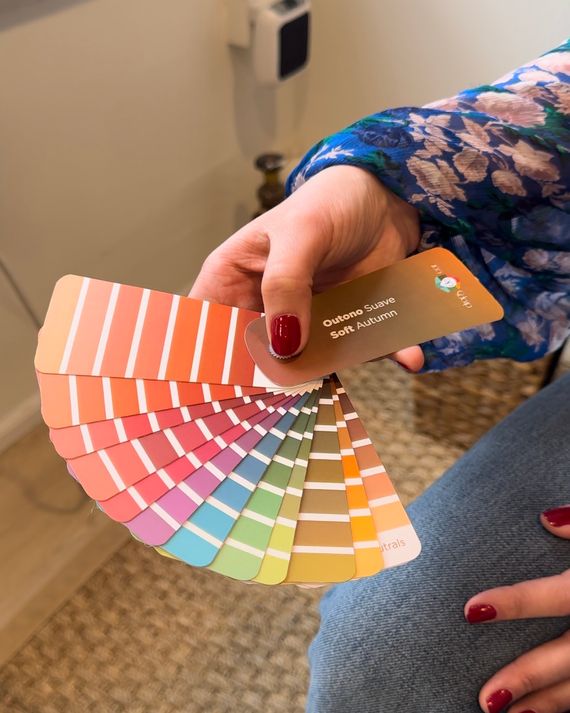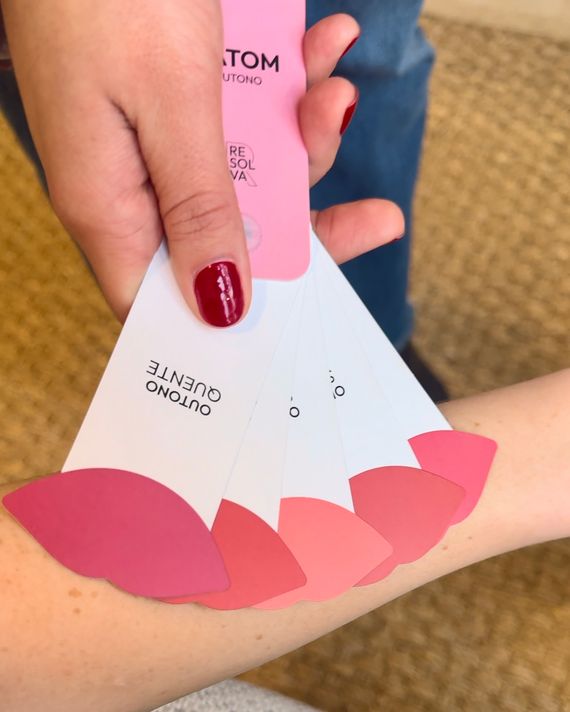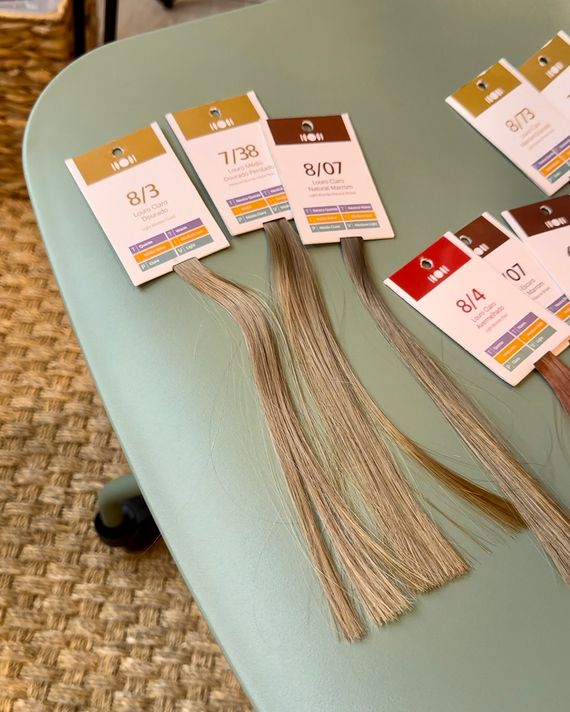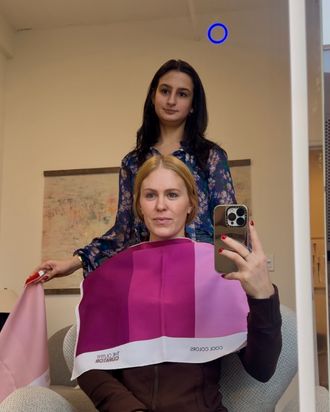
On TikTok, cultural moments and trends of decades past are often memorialized or rediscovered by a new generation — whether it be an old song like “Dreams” by Fleetwood Mac, a cult-favorite television show like Suits, or, most recently, the once-popular practice of personal color analysis. Even though the concept of determining how certain colors affect your appearance has actually been around since the 1970s and ’80s, color analysis has definitely experienced a resurgence over the past few months. So much so, that some are flying to South Korea (where the service is hugely popular) in order to find their ideal color palette, according to professional color analysts. Spoiler alert: I did not travel 15 hours in order to write this story, but I did book a color analysis appointment in New York City to see if this trendy service is worth the hype.
Much to my surprise, there are only a handful of color-analysis studios in the New York metropolitan area. I was also surprised to find that an hour-long appointment can run you close to $300. I ended up booking an in-person session with a company called the Outfit Curator. It was founded in 2019 by Mariana Marques — who studied color analysis in her home country of Brazil.
@isabelle.lux Color Analysis (pt3) silver vs gold in Seoul Korea with Meime ❤️ #coloranalysis #silvervsgold #skinundertone Gold and silver color analysis in Korea How to find your undertone storytime Silver or gold jewelry Cool tone skin Warm tone skin
♬ Aesthetic - Tollan Kim
The verdict on social media is pretty split. In this clip, for example, influencer Victoria Garrick Browne’s followers went as far as to question if she was being “gaslit” into believing certain colors look better than others. But when the theory is applied to celebrities in photos that show how certain hair colors, blushes, or lipstick shades drastically impact the appearance of people like Selena Gomez, Anne Hathaway, and Rihanna, the idea can be quite convincing.
@nathalia_vaz Replying to @jtt.46 Let’s talk about this beauty queen, RiRi! She has a soft apperance with a muted skintone. My guess for her is a soft summer! Muted tones with cool undertones highlight her natural beauty. #colorseason #summer #coloranalysis #imageconsultant #coloranalysistiktok #rihanna #softsummer #nathaliaevaz
♬ Guud Gurls - BREAKING BEATTZ
I also assumed that I could probably perform a professional color analysis on myself, just due to the fact that I select clothing, accessories, jewelry, and other colorful items every day for a living. Suffice to say, I was wrong about the entire experience. And I don’t think social media is doing color analysis justice (TikTok makes it out to be a quick service that utilizes basic color theory, but my appointment was in-depth, informative, and worthwhile). Let me explain:
What Is Color Analysis?
Color analysis is the process of determining which colors are the most flattering, based on natural features like your eye color, skin tone, and hair color. Results are usually categorized by season (spring, summer, autumn, or winter) then more specifically by contrast (low to high), undertone (cool, warm, or neutral), value (light to dark), and saturation (soft to bright).
How to Find Your Season
Even though the most accurate way to determine your season is to do an in-person color analysis so a trained professional can see how each shade impacts your dark circles, lip color, eye color, and overall complexion, you can make a solid guess based on these guidelines: winter usually refers to people with cool undertones, dark hair, and vibrant eyes; summer usually refers to people with cool undertones, light hair, and light eyes; autumn usually refers to people with warm undertones, dark hair, and dark eyes; and spring usually refers to people with warm undertones, light hair, and light eyes. Another factor that comes into play is contrast, which refers to the difference between skin tone and hair color. Someone with low contrast, for example, might have dark hair and dark skin, whereas someone with high contrast might have black hair and light skin. So even though I have warm undertones, light strawberry-blonde hair, blue eyes, and light skin, I was told during my appointment that I am an autumn — not a spring — because I have low contrast and look better in dark colors rather than bright ones. Drew Barrymore is also a soft autumn, according to the internet, while Janelle Monàe is a true winter, Emma Stone is a bright spring, and Margot Robbie is a light summer.
What Should I Expect During a Color-Analysis Appointment?
My appointment started with an explanation of the history of color analysis, as well information about the process and how it can help me get dressed in the morning. My pro then decided if I am a cool-toned or warm-toned by holding different colored fabrics close to my face. The draping process helps determine your season, hue, value, and chroma. Next, the pro decided which metals (silver, gold, or rose gold), lipstick and blush shades, and hair colors would look best on me by using a similar method.
I loved how interactive and informative the session was; my pro, Sophia, was great about explaining what she was looking for so I could better understand color analysis and utilize her techniques when I’m shopping or getting dressed in my day-to-day life. And after the appointment, I received an email with a PDF of everything that was discussed during my session. Here is what I learned: I’m a a soft autumn with low contrast, medium brightness, soft saturation, and a neutral warm undertone. My ideal colors are dark olive green, royal blue, coral tones, and muted brown shades. And because I have low contrast, monochromatic looks are particularly flattering on me. Along with a summary of what it means to be a soft autumn, the PDF also had several pages of outfit-inspiration photos, hair color, and makeup products with shade names that will enhance my complexion, including the Saie Dew Blush in a bright color called Poppy, Lancôme Teint Idole foundation in 240w (which is described as a shade for people with light-to-medium skin tones and warm/yellow undertones), Chanel Healthy Glow Natural Eyeshadow Palette in Beige, and M.A.C Powder Kiss lipstick in a dirty peach called Mull It Over.
What Are the Benefits of Color Analysis?
It’s probably best to do one before an investment purchase or a major hair change. My pro said she often has clients who are in the process of building a capsule wardrobe and want make sure they are investing in color palettes and tones that flatter them. She said she also has people come in before wedding-dress appointments to get a sense of what type of white they should look for and even before a hair appointment so they can find their perfect shade and tone.
Color analysis is also beneficial for people who struggle with color matching complexion products like foundation and bronzer; finding your undertone can be hard and shopping for makeup online is ever harder, so professional guidance about warm-versus-cool-versus-neutral shades can be super useful. If any of this resonates with you, color analysis is definitely worth the money. If not, at the very least it’s a fun party activity.
So, Does Color Analysis Work?
To be honest, I couldn’t always see what my color analyst was seeing. Much like professionals in the viral TikToks, she was able to decide after just a few seconds if a color was flattering on me or not. In some cases, the impact of a color was drastic — dark greens really brightened up my complexion and brought life into my eye, for example, whereas soft orange-y hues totally washed me out — but with other colors, the effect was barely noticeable. Still, it was interesting to hear her reasoning. And toward the end of my appointment, I started to grasp the process and pick up on her methods. None of the results or recommendations were too surprising, since I already knew my undertone, but it was nice to have confirmation from a professional and gain a better understanding of color theory.


